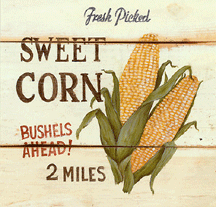
Volume XVII, Issue 31 # July 30 - August 5, 2009 |
 |
by Dr. Frank Gouin
Getting to the Root of Sweet Corn
 Super-sweet hybrids are not super hardy
Super-sweet hybrids are not super hardy
If you had difficulty growing sweet corn in your garden this year, you are not alone. I replanted some corn up to three different times. The overabundance of rain this spring is the major contributor to our problem. I also read a research paper that blames some of the problems on the new super-sweet hybrid varieties now sold. It appears that many of the sugar-enhanced or super-sweet varieties are not as vigorous and are more easily attacked by root rot organisms.
It may be that the problem with root rot in the enhanced-sugar or super-sweet varieties is the limited energy reserves in those seeds. If you compare the size of seeds of these varieties with those of the standard varieties, you will note that seeds of the standard varieties are not only heavier but also appear to be more plump and less wrinkled.
When you plant corn, soil temperatures should be above 60 degrees. If you have a heavy soil like I do, plant the seed very shallow; even consider building a ridge of soil and plant on top of the ridge. Once the seeds have germinated and the roots have become established, the seedlings appear more resistant to root rot.
If you had a root rot problem this year, I strongly recommend planting a cover crop of wheat or winter rye late this summer — or as soon as you finish harvesting. Plowing under a good heavy cover crop in the spring will encourage the growth of beneficial microorganisms that will provide biological control of the root rot organisms next spring. A cover crop of wheat or winter rye will not only retain nutrients that would otherwise leach away during the winter months, it will also add organic matter to the soil.
In addition to growing a heavy cover crop of winter rye in my garden each fall, I also add compost.
Sweetness in Corn
Q How should we treat sweet corn to keep it sweet?
–Sandra Olivetti Martin, Bay Weekly Editor
A Corn should be picked before dawn because sugar is translocated after dark from the stalk to the ear. Once the sun strikes the ear, the sugar begins again to translocate to starch.
On big business farms, corn picked in the field is drawn by the case through ice baths, then packed in refrigerated trucks.
Farmers selling corn should keep it covered under a wet tarp. When you bring it home, store it in your refrigerator.